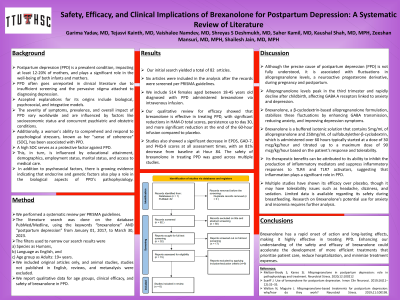Women's Mental Health
Session: Poster Session
(208) Safety, Efficacy, and Clinical Implications of Brexonolone for Postpartum Depression: A Systematic Review of Literature

Trainee Involvement: No

Garima Yadav, MD (she/her/hers)
Child and Adolescent Psychiatry Fellow
Texas Tech University, Permian Basin
Midland, Texas, United States.jpeg.jpg)
Tejasvi Kainth, MD
PGY1 Resident Physician
BronxCare Health System
New York City, New York, United States
VAISHALEE NAMDEV, MBBS
Graduate student
University of South Florids
Vancouver, Washington, United States- SD
Shreyas Deshmukh, MD
PGY-1 Resident
The Wright Center for Graduate Medical Education
Scranton, Pennsylvania, United States - SK
Saher Kamil, MD
Clinical Documentation Specialist
Dell Children’s Medical Center
Austin, Texas, United States - KS
Kaushal Shah, MD, MPH
Resident Physician
Wake Forest Baptist University
Winston Salem, North Carolina, United States - ZM
Zeeshan Mansuri, MD, MPH
PGY-6, Child and Adolescent Emergency Psychiatry Fellow
Boston Children’s Hospital/Harvard Medical School
Boston, Massachusetts, United States
Presenting Author(s)
Co-Author(s)
Objective: Postpartum depression (PPD) is a prevalent condition that affects 12-20% of new mothers; that emerges within 4 to 12 weeks after childbirth. In March 2019, brexanolone, an intravenous medication, was approved for treating PPD. This review aims to provide a qualitative analysis of the effectiveness, clinical benefits, and safety of brexanolone in managing PPD.
Methods: We performed a systematic review per PRISMA guidelines. We did the literature search on the database PubMed/Medline, using the keywords "brexanalone" AND "postpartum depression" from January 01, 2017, to March 30, 2023. The filters used to narrow our search results were a) species as Humans, b) language as English, and c) age group as adult: 19+ years. We included original articles only, and animal studies, studies not published in English, reviews, and we excluded metanalysis. We report qualitative data for age groups, clinical efficacy, and safety of brexonolone in PPD.
Results: Our initial search yielded 15 articles. After we screened the records per PRISMA guidelines, we included 6 articles in the analysis. We have 514 females aged between 18-45 years old diagnosed with PPD administered brexanolone via intravenous infusion. Our qualitative review for efficacy showed that brexanolone is effective in treating PPD, with significant reductions in HAM-D total scores, persistence up to day 30, and greater reduction at the end of the 60-hour infusion compared to placebo. Studies also showed a significant decrease in EPDS, GAD-7, and PHQ-9 scores at all assessment times, with an 81% decrease from baseline at Hour 84. The safety of brexanolone in treating PPD was good across multiple studies.
Discussion: Brexonolone is a buffered isotonic solution that contains 5mg/mL of allopregnanolone and 250mg/mL of sulfobutylether-β-cyclodextrin, which is administered over 60 hours typically started at a dose of 30 mcg/kg/hour and titrated up to a maximum dose of 90 mcg/kg/hour based on the patient's response and tolerability. Its therapeutic benefits can be attributed to its ability to inhibit the production of inflammatory mediators and suppress inflammatory responses to TLR4 and TLR7 activators, suggesting that inflammation plays a significant role in PPD.
Conclusion: Brexanolone has a rapid onset of action and long-lasting effects, making it highly effective in treating PPD. Enhancing our understanding of the safety and efficacy of brexanolone could accelerate the development of more efficient treatments that prioritize patient care, reduce hospitalization, and minimize treatment expenses.
References:

